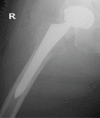Short-term Success in Treatment of an Acute Hematogenous Periprosthetic Hip Joint Infection with Debridement, Antibiotics, and Implant Retention
- PMID: 38681921
- PMCID: PMC11043975
- DOI: 10.13107/jocr.2024.v14.i04.4354
Short-term Success in Treatment of an Acute Hematogenous Periprosthetic Hip Joint Infection with Debridement, Antibiotics, and Implant Retention
Abstract
Introduction: Periprosthetic joint infection (PJI) is an unfortunate but frequent complication following total hip arthroplasty, with an incidence of 1%. Debridement, antibiotics, and implant retention is a treatment option for acute hematogenous PJI, with success rates reported up to 70%. Here, we present a case demonstrating short-term success using this treatment approach in a 74-year-old medically infirm patient.
Case report: The patient - a 74-year-old male with well-functioning bilateral total hip arthroplasties performed 14 years prior - presented to a rural emergency department with an acute onset of right groin pain and dizziness. The patient was found to have sepsis, a right hip joint effusion, and periarticular abscesses on assessment. Synovial fluid aspiration from the right hip grew methicillin-sensitive Staphylococcus aureus. The patient was transferred to an outside hospital for limited debridement of the right hip joint, followed by transfer to our tertiary hospital. On arrival, consideration was given to performing an exchange arthroplasty. However, given the patient's medical frailty, it was felt that the risks were prohibitive, as supported by the presence of ileus, severe electrolyte imbalance, anemia requiring transfusion, anasarca, and vancomycin-resistant Enterococcus faecium infection of a sacral wound. The patient underwent surgery utilizing an established protocol of aggressive debridement and cleaning of the hip space, exchange of the modular arthroplasty components, and placement of antibiotic calcium sulfate beads for local delivery. The patient was treated with parenteral antibiotics followed by chronic oral antimicrobial suppression for 10 months after the final surgery. During treatment, the patient's inflammatory markers have normalized. The patient is ambulatory without assistive devices but uses an ankle orthosis due to a post-operative foot drop that did not resolve. The patient has regained satisfactory mobility with an Oxford hip score of 27.
Conclusion: This case demonstrates short-term success in the treatment of acute hematogenous PJI in a medically infirm patient utilizing debridement, antibiotics, and implant retention and may serve to inform future patient counseling.
Keywords: Joint infection; and implant retention; antibiotics; debridement; revision arthroplasty; total hip arthroplasty.
Copyright: © Indian Orthopaedic Research Group.
Conflict of interest statement
Conflict of Interest: Nil
Figures




Similar articles
-
Poor Outcomes of Irrigation and Debridement in Acute Periprosthetic Joint Infection With Antibiotic-Impregnated Calcium Sulfate Beads.J Arthroplasty. 2017 Aug;32(8):2505-2507. doi: 10.1016/j.arth.2017.03.051. Epub 2017 Mar 29. J Arthroplasty. 2017. PMID: 28434697
-
Outcomes of Acute Hematogenous Periprosthetic Joint Infection in Total Ankle Arthroplasty Treated With Irrigation, Debridement, and Polyethylene Exchange.Foot Ankle Int. 2018 Nov;39(11):1266-1271. doi: 10.1177/1071100718786164. Epub 2018 Jul 4. Foot Ankle Int. 2018. PMID: 29972076
-
Debridement, Antibiotics, and Implant Retention for Acute Periprosthetic Joint Infection.Orthop Surg. 2020 Apr;12(2):463-470. doi: 10.1111/os.12641. Epub 2020 Mar 11. Orthop Surg. 2020. PMID: 32159296 Free PMC article.
-
The Role of Long-Term Antibiotic Suppression in the Management of Peri-Prosthetic Joint Infections Treated With Debridement, Antibiotics, and Implant Retention: A Systematic Review.J Arthroplasty. 2020 Apr;35(4):1154-1160. doi: 10.1016/j.arth.2019.11.026. Epub 2019 Dec 9. J Arthroplasty. 2020. PMID: 31955984
-
Treatment of acute periprosthetic infections with prosthesis retention: Review of current concepts.World J Orthop. 2014 Nov 18;5(5):667-76. doi: 10.5312/wjo.v5.i5.667. eCollection 2014 Nov 18. World J Orthop. 2014. PMID: 25405096 Free PMC article. Review.
References
-
- Sloan M, Premkumar A, Sheth NP. Projected volume of primary total joint arthroplasty in the U.S., 2014 to 2030. J Bone Joint Surg Am. 2018;100:1455–60. - PubMed
-
- Bozic KJ, Kurtz SM, Lau E, Ong K, Vail TP, Berry DJ. The epidemiology of revision total hip arthroplasty in the United States. J Bone Joint Surg Am. 2009;91:128–33. - PubMed
-
- Alp E, Cevahir F, Ersoy S, Guney A. Incidence and economic burden of prosthetic joint infections in a university hospital:A report from a middle-income country. J Infect Public Health. 2016;9:494–8. - PubMed
Publication types
LinkOut - more resources
Full Text Sources
